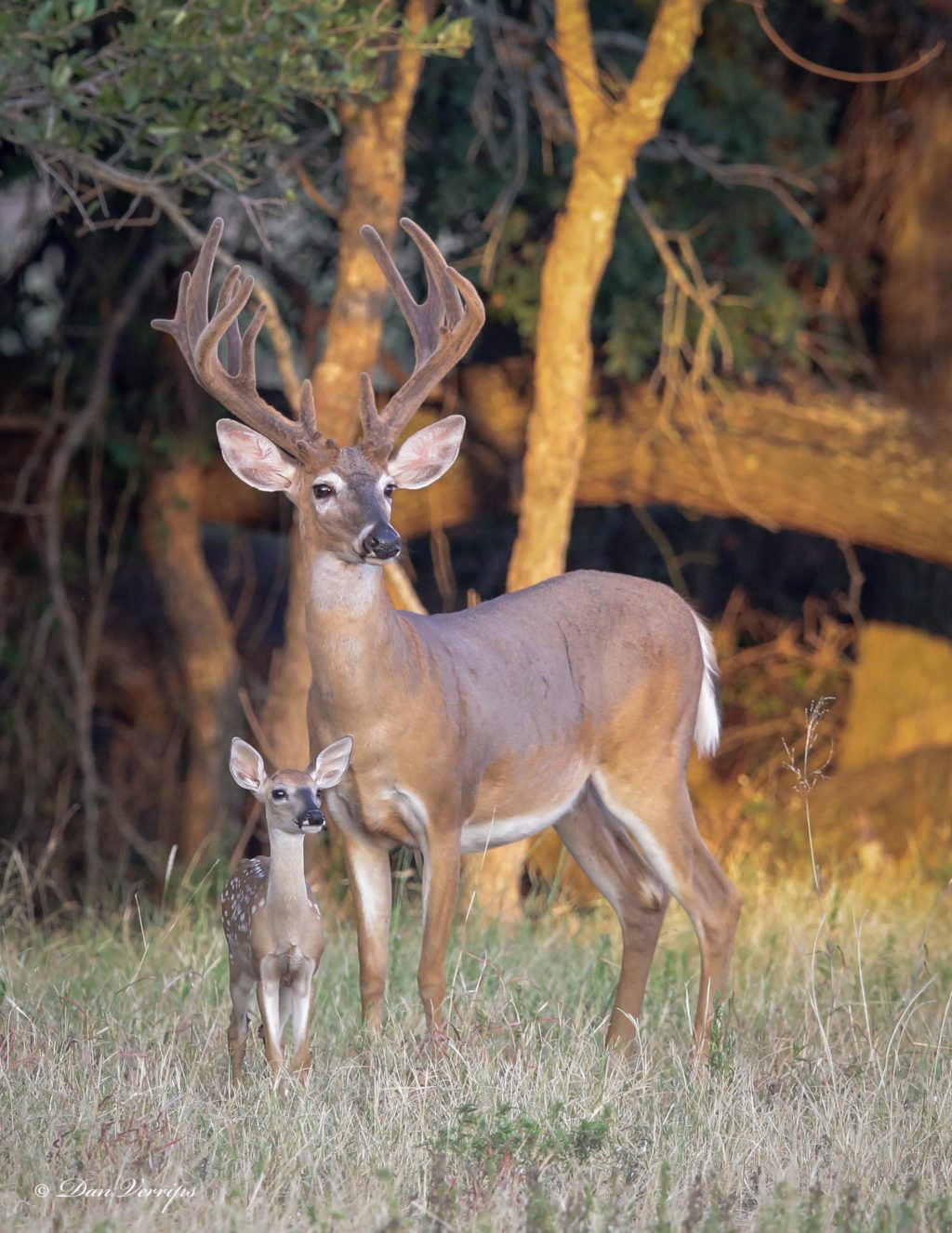
How many deer are in Texas? White-tailed deer populations listed by region
There are approximately 5.6 Million White-tailed deer in Texas. This is according to the most recent (2019) population estimates conducted by Texas Parks and Wildlife (TP&W).
According to the same state estimates, White-tail populations have consistently increased since 1989 where they were estimated to number around 3.5 Million. By 2015, there were estimated to be around 4 Million White-tailed deer in Texas and by 2018 they had an estimated population of 4.6 Million.
The most heavily populated area of the state BY FAR is the Edwards Plateau and the Texas Hill Country where there can be as many as 293 deer per 1,000 acres. This region is almost 3 times as densely populated as any other region of the state.
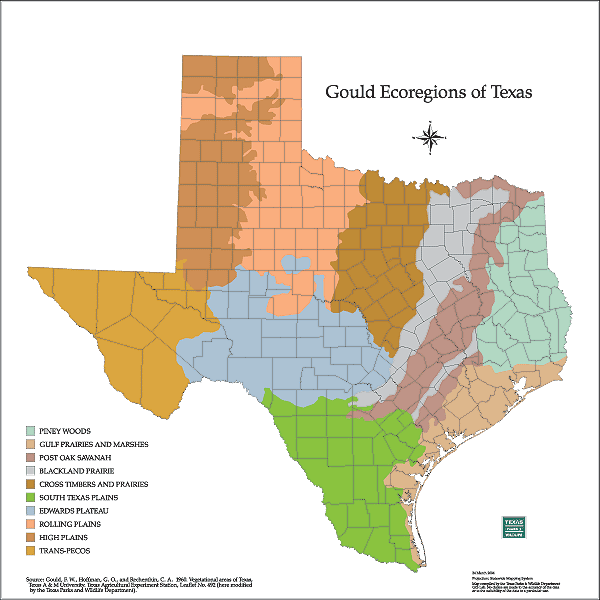
The least densely populated area is Trans-Pecos where there are areas with no White-tailed deer at all. Blackland prairie regions of the state also exhibited lower average populations which hovered around 9 deer per 1,000 acres. Don’t worry, I break the populations down by region below and give you a TON of information on each region.
Population data is acquired regionally by TP&W with half of the state surveyed each year. In the estimate above, I combined population estimates from the half of the state surveyed in 2018 and the other half of the state surveyed in 2019.
Now, I should qualify that there were a few missing regions in the data set I received from TP&W. Six of the 41 areas did not have population data associated with them, so there are likely more than 5.6 Million White-tailed deer in Texas. However, 4 of those regions represented sparsely populated areas such as the western portions of the panhandle and much of the Trans-Pecos region of the state.
In most cases the limiting factor for White-tailed deer populations is food availability. Rarely are water or cover limiting factors until you get to the Trans-Pecos region of Texas. For more information on the diets of White-tailed Deer, check out our comprehensive article What do deer eat?
Texas Deer Populations and Density
Here is a region by region breakdown of estimated Deer Populations in Texas and the average density listed in average number of acres per deer.
There are WAY more White-tailed deer in the Edwards Plateau region of the state than anywhere else in Texas.
| Region | Deer Population | AVG # of Deer / 1,000 Acres |
| Edwards Plateau | 2,324,000 | 147 |
| Post Oak Savannah | 793,000 | 46 |
| Cross Timbers & Prairies | 767,104 | 59 |
| Eastern Rolling Plains | 475,768 | 39 |
| South Texas Plains | 437,990 | 29 |
| Western Rolling Plains | 324,539 | 27 |
| Piney Woods | 286,908 | 19 |
| Trans Pecos | 110,140 | 37 |
| Gulf Coast Prairies | 42,600 | 23 |
| Blackland Prairies | 22,628 | 9 |
| TOTAL | 5,584,677 |
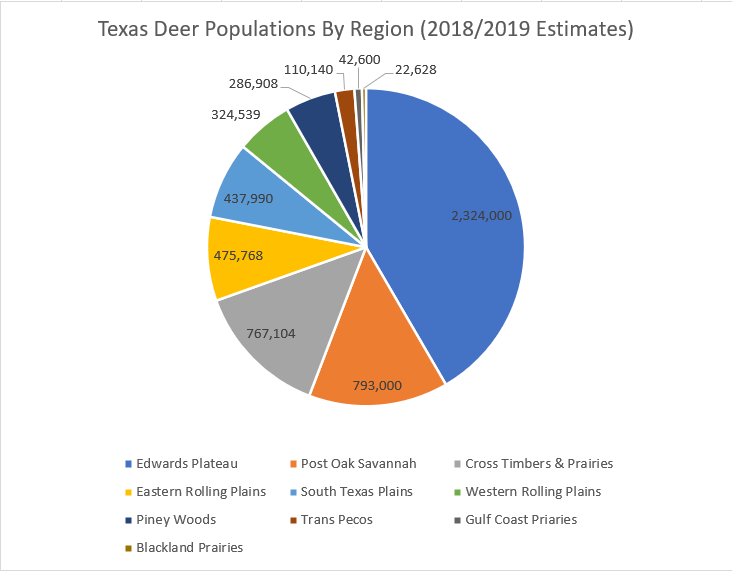
Texas Deer Populations by Region
In this section I break down deer populations by Ecoregions of the state. For more information about each Ecoregion check out the Texas Ecoregions page from Texas Parks and Wildlife.
If you’re wanting to know which ecoregions produce the largest deer, check out his article Where are the BIGGEST DEER in Texas? !
Before looking at the information below it’s important to understand that Texas Parks and Wildlife subdivides all ecoregions into smaller Deer Management Units (DMU’s) which are shown below. Each DMU is now independently surveyed for deer every other year, although historically they were surveyed every year.
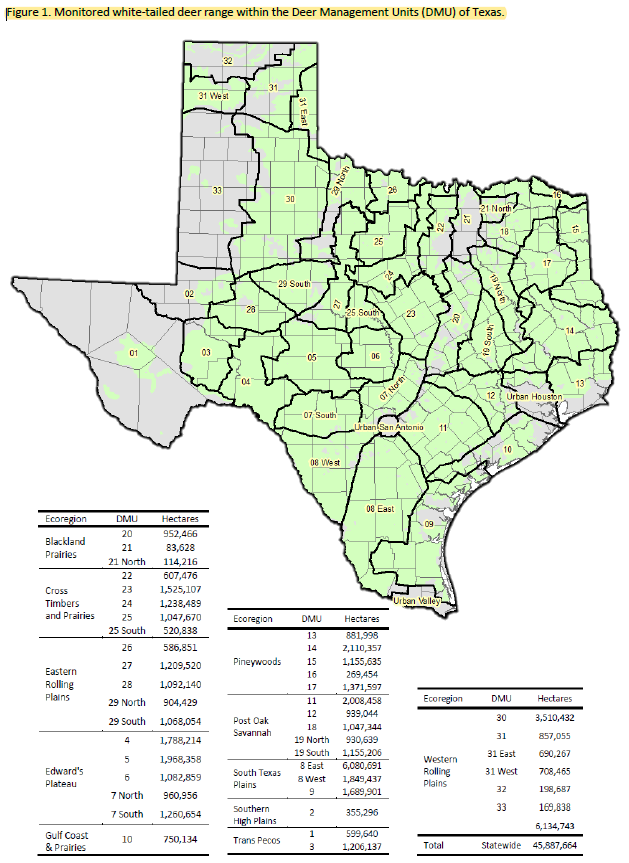
Texas Deer Populations on the Edwards Plateau
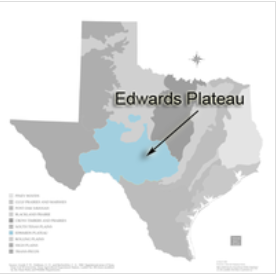
The Edwards Plateau is the area in Central Texas known mostly as the Texas Hill Country. As an ecoregion it represents over 17 Million Acres and receives 15-30 inches of rainfall annually.
As I mentioned above, this region is the most densely populated area of the state.
The Edwards Plateau ecoregion consists of 5 Deer Management Units (DMU) comprised of DMU 4, 5, 6, 7 North, and 7 South. For the purposes of this article I summed the estimated survey data from these 5 DMU’s for every year since 2005.
As expected, the White-tailed Deer populations are growing significantly in the Texas Hill Country. Populations went from an estimated 1.5M in 2012 to almost 2.4M during the 2018/19 census.
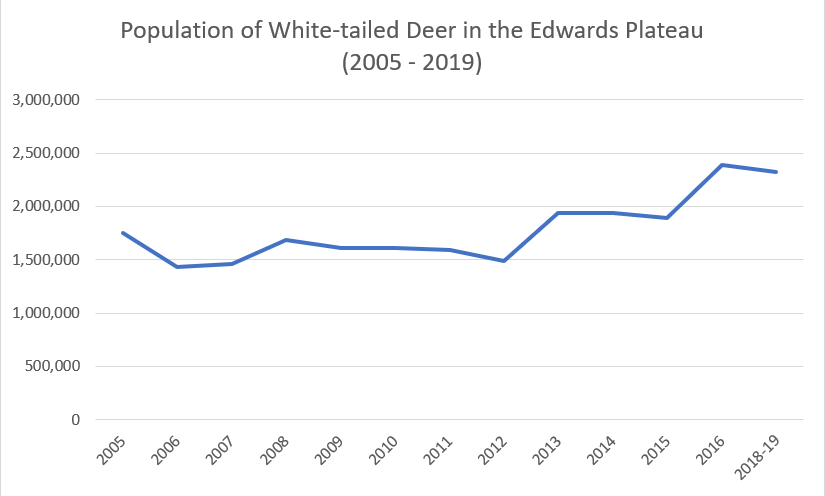
Deer density within the Edwards Plateau varied wildly with an estimated 94 deer per 1,000 acres in DMU 5 (Schleicher, Menard, Kimble, & Sutton Counties) to an estimated 293 Deer per 1,000 acres in DMU 6 (Llano, San Saba, Gillespie, and Keer Counties). DMU 6 holds the highest deer density anywhere in the state of Texas.
White-tailed Deer Density on the Edwards Plateau
| Region | DMU | DEER/1000 Acres |
| Edwards Plateau | 4 | 96 |
| Edwards Plateau | 5 | 94 |
| Edwards Plateau | 6 | 293 |
| Edwards Plateau | 7 North | 175 |
| Edwards Plateau | 7 South | 77 |
Texas Deer Populations on the Cross Timbers and Prairies
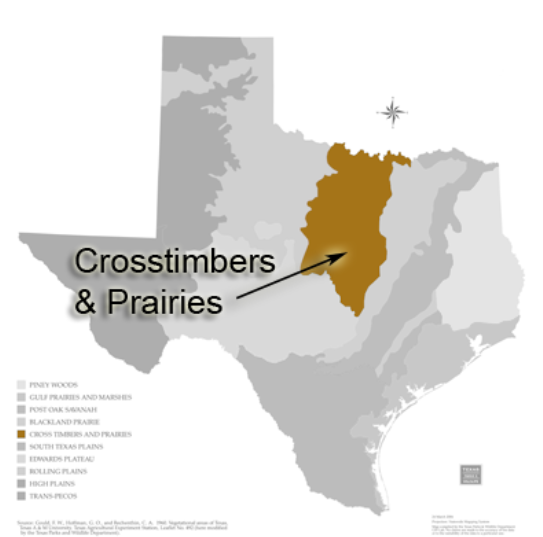
The Crosstimbers & Prairies region of the state is the southern most region of America’s tall grass prairie. It consists mostly sandy and loamy soils with woodlands sporadically mixed through the region.

Like many other area ecoregions of the state, the Crosstimbers & Prairies has shown consistent increase in White-tailed deer populations since 2005. This region is divided into DMU’s 22, 23, 24, 25, and 25 South.
Deer densities vary wildly across this ecoregion from 14 deer / 1,000 acres in DMU 22 (Cooke, Denton, and Tarrant Counties) to an estimated 88 deer / 1,000 acres in DMU 23 (Hamilton, Coryell, and Lampassas Counties).
White-tailed Deer Density in the Crosstimbers and Prairies
| Region | DMU | DEER/1000 Acres |
| Cross Timbers & Prairies | 22 | 14 |
| Cross Timbers & Prairies | 23 | 88 |
| Cross Timbers & Prairies | 24 | 51 |
| Cross Timbers & Prairies | 25 | 58 |
| Cross Timbers & Prairies | 25 South | 81 |
Texas Deer Populations in the Pineywoods of East Texas

This region receives the highest rainfall quantities of any other ecoregion of the state with an average of over 35″ annually across the region.
The Pineywoods of East Texas has seen a consistent increase in the estimated populations of White-tailed Deer since 2005 almost doubling in that time frame.

The density of White-tailed deer in the Pineywoods is much lower on average compared to the deer density in other areas of the state. It’s as low as 7 deer per 1,000 acres in DMU 13 which is the Southeaster most region of the state representing Chambers, Jefferson, Hardin, and Liberty counties.
Now I suspect these low estimates may not be representative of how many deer are really in this ecoregion. This area is particularly difficult to survey with much of the area permanently marshy with very thick woodland cover.
The highest deer density in the Pineywoods of East Texas comes from DMU 14 which consists mostly of Polk, Jasper, Angelina, Tyler, San Augustine, and Newton counties.
White-tailed Deer Density in the Pineywoods
| Region | DMU | DEER/1000 Acres |
| Piney Woods | 13 | 7 |
| Piney Woods | 14 | 25 |
| Piney Woods | 15 | 16 |
| Piney Woods | 16 | 23 |
| Piney Woods | 17 | 23 |
Deer Populations in the Post Oak Savannah
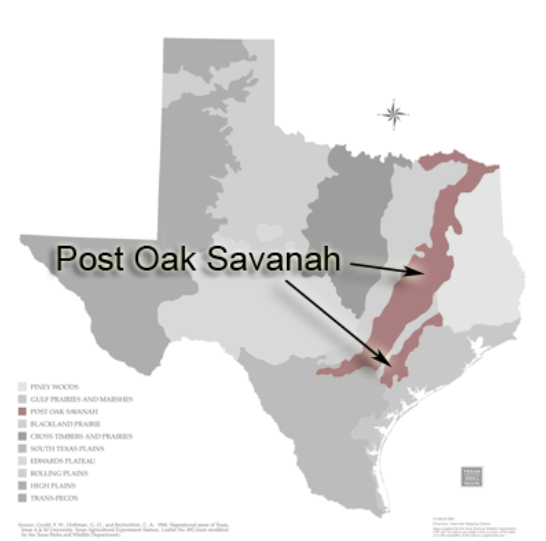
The Post Oak Savannah ecoregion is a transition area from the Pineywoods of East Texas to the Cross Timbers and Blackland Prairies. It exhibits similar landscape features as the Crosstimbers and Prairies but receives more rainfall. Those of you have been to College Station have been in the heart of the ecoregion.
The Post Oak Savannah has exhibited the most dramatic increase in estimated deer populations of any ecoregion since 2005. The estimated deer populations have tripled in the last 15 years!

This ecoregion is subdivided into DMU’s 11, 12, 18, 19 North, and 19 South. The deer densities here vary greatly depending on which part of the Post Oak Savannah you’re in. The region with the lowest estimated deer density is DMU 18 which represents Rains, Hunt, Hopkins, Delta, and Lamar counties. This is the northern most DMU in the Post Oak Savannah.
However, DMU 11 which represents Colorado, Fayette, Lavaca, Caldwell, Gonzales, and Dewitt counties, exhibits the highest deer density of any DMU outside of the Edwards Plateau.
| Region | DMU | DEER/1000 Acres |
| Post Oak Savannah | 11 | 90 |
| Post Oak Savannah | 12 | 38 |
| Post Oak Savannah | 18 | 26 |
| Post Oak Savannah | 19 North | 40 |
| Post Oak Savannah | 19 South | 36 |
Deer Populations in the South Texas Plains
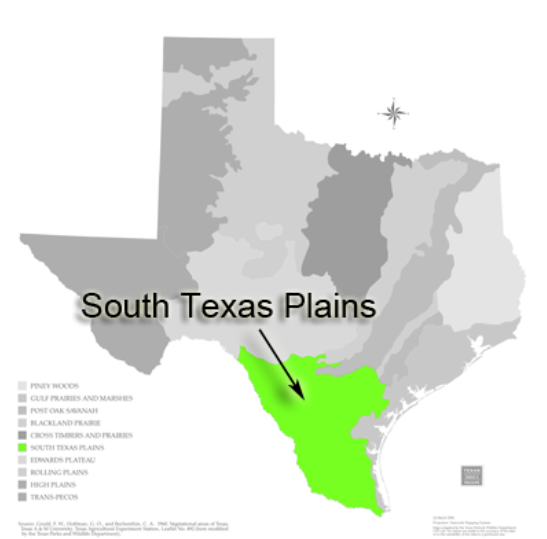
The South Texas Brush Country is one of the most famous regions in the world for White-tailed Deer Hunting. It’s home to the golden triangle which is arguably the mecca of trophy deer hunting. It’s know for it’s prickly pear, thorny bushes, and hot summer temperatures. Rainfall averages 20-30 inches annually and decreases as you head west through the region.
Of all of the data I was most excited to see around deer populations, I held my breath the most to uncover what South Texas held. Unfortunately, after reviewing the results I found estimates that varied wildly from year to year. This to me indicates variability in collection or a low confidence in the results. Although I’m showing it here I’m least confident in the estimates provided as well as the trends indicated.
In fairness to Texas Parks and Wildlife, who collect and publish the data, they also publish the 95% confidence intervals from data collected. The confidence intervals also indicate a low confidence in the estimates in South Texas.

The are of South Texas with the highest density of White-tailed Deer is DMU 8 West which represents Maverick, Zavala, and Dimmit counties.
| Region | DMU | DEER/1000 Acres |
| South Texas Plains | 9 | 31 |
| South Texas Plains | 8 East | 16 |
| South Texas Plains | 8 West | 40 |
About the Author:
Michael Morrow is the founder of the Texas Landowner’s Association and a land agent in the state of Texas. He is dedicated to ensuring landowners have the resources, information, and platform they need to effectively accomplish their personal goals for their property. His undergraduate and graduate level studies at Texas A&M were focused around Rangeland Ecology and Wildlife Management. He’d love to help you with your next purchase or help take your property to market. You can reach him here by emailing Michael@LandAssociation.org

3 thoughts on “How many deer are in Texas? White-tailed deer populations listed by region”
Comments are closed.